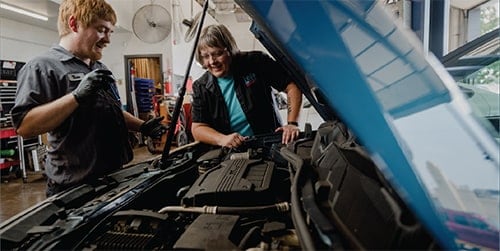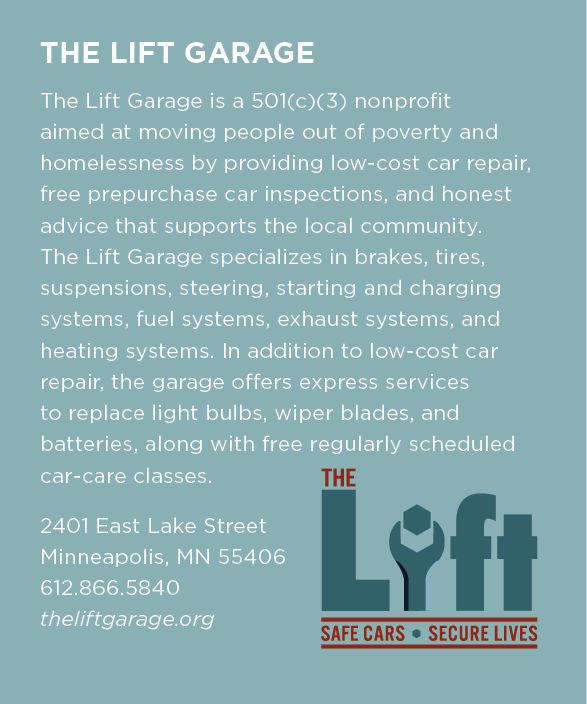Repairing Brakes, Mufflers, and Dignity
Heying (pronounced Hi-ing), 50, who has a Bachelor of Science degree in social work as well as a Master of Pastoral Ministry degree, grew up in Ossian, Iowa. The youngest of seven siblings, she learned the value of caring for the less fortunate from her devout Catholic parents.
“My oldest brother has Down’s syndrome,” Heying says. She remembers her parents were told to put their disabled son in an institution and move on with their lives. “But that was not the choice they made,” she says. Instead, Heying grew up with a fierce understanding of making room for everyone.
After graduating from college, she worked for more than a decade as a social worker and pastoral minister for St. Stephen’s Human Services, an independent nonprofit organization fighting poverty and homelessness. There, she learned firsthand how important car repair is for people who are underserved.
“I heard it repeatedly,” says Heying. Clients told her, “I can’t afford to get my car fixed, and I’m going to lose my job.” Without the ability to pay rent, they could easily find themselves living on the streets.
Oftentimes, she helped someone push a broken-down vehicle around the block so it wouldn’t get towed.
Clients would live in their cars when they couldn’t get a bed at the homeless shelter, Heying says. One client stayed in his automobile so frequently that when he applied for a job, he would give his address as 1994 Nissan Maxima Avenue.
“The details of the stories were different, but everything depended on a car repair,” she says. She was plagued with a recurring thought: Somebody should do something about it.
The Pros and Cons
Heying began agonizing over returning to school to become an auto mechanic. She loved her social services career and was still paying graduate school loans. “I wrote a pro and con list, and there was nothing in the pro column,” she says.
“You know it’s a calling—or something bigger—when you make a list and there is nothing in that pro column, but you can’t stop thinking about it,” Heying says. “There was no logical reason to do it, but I kept seeing the need and thought, ‘Somebody needs to make this happen.’”
So, at age 38, Heying enrolled in a two-year associate degree program in auto technology at Dunwoody College of Technology. “I went into the whole thing reluctantly,” Heying says. She walked into the first day of class thinking, “Why am I taking out more student loans to get a degree I don’t particularly want to get, that I don’t know if I’ll be good at, to meet a need I don’t know how to meet?”
Shutting Out Self-Doubt
Heying had changed the oil in her motorcycle a few times but knew little else about auto repair. “I’m good at organizing people and talking about feelings,” Heying says. “Those are more my wheelhouse than fuel injection.”
She remembers her first day of class at Dunwoody. Automotive instructor Dave DuVal told the students to face the wall where the crankshafts were hanging. Heying didn’t know which way to turn, so she followed the lead of the young men in the class. “I was very much a novice,” Heying says. “It was a huge and humbling learning experience.”
Heying doubted her decision for months, she says. “The whole thing was awful. I loved Dunwoody, let me be clear, but in a program that is designed largely for 18-year-old boys, there is a different energy and style that involves a lot of yelling and drill-sergeant-like talking.”
She often thought she didn’t fit in and considered giving up. “Halfway through the first semester, I could not flare brake lines for the life of me,” Heying says. “I couldn’t do it, and, one day, I burst into tears.”
Embarrassed and humiliated, she was ready to quit, but DuVal talked with her. Heying told him about the need in the community for reasonably priced auto repairs. That day, DuVal told Heying she had a great vision and committed to helping her every step of the way.
She finally got the brake line flared and kept forging ahead.
Showtime
While attending Dunwoody, Heying continued working as a social worker. After her 2010 graduation, she honed her skills with a part-time job at a Sears Auto Center. She started to research her next steps by talking with lawyers, financial experts, executive directors of nonprofit organizations, and garage owners. Then, in April 2013, with one rented bay, Heying opened The Lift Garage in Minneapolis, a nonprofit car repair shop that offers low-cost automobile repairs and heartfelt advice to those in need.
The garage had one customer the first day. The first person appointed to The Lift Garage’s board of directors, Dunwoody automotive instructor Dave DuVal, was onsite—ready and willing to help repair an old Jeep Cherokee owned by a woman with disabilities. The car “was in shambles,” DuVal says. “It needed brakes and steering components.”
DuVal and Heying spent two weekends getting the Cherokee going. “That woman was so thankful,” DuVal says. “Seeing [the owner’s] gratitude was the fuel that kept feeding our innate desire to help these folks.”
From there, it went crazy, Heying says. Initially staffed by volunteers, The Lift Garage now employs 12 people, including five mechanics operating five bays in a garage the nonprofit purchased in 2020. They see 130 cars a month. Appointments are scheduled a month in advance, and there are always hundreds more people wanting repairs.
Prioritizing Dignity
The staff’s work goes beyond tuneups and oil changes, says Heying. It’s the human side of the work that’s rewarding to her. “I regularly joke that we are social workers, resource specialists, grief counselors, and financial counselors—and we fix cars on the side,” she says. In fact, The Lift Garage’s core values are hospitality and dignity. “We try to meet people where they are,” Heying says. “Most people who walk through the door are in some level of crisis.”
There are a lot of pieces to it, says Heying, who helps customers think through and resolve issues in a way that honors their lives, experiences, and intelligence: “We try to leave a lot of room for grace, knowing there is always more to the story than what we see.”
In some cases, Heying has to tell customers that their vehicle is not worth repairing, or that it wouldn’t be safe to drive, even with repairs. Recently, she told a gentleman that his 1998 Buick LeSabre with 280,000 miles would cost $1,800 to repair, but the vehicle was worth only about $800. He chose to repair it because he said he couldn’t buy a better vehicle for $1,800.
“We don’t invest in vehicles if the transmission is gone or there is catastrophic rust in structural areas,” Heying says. “People sometimes beg us to do it, but we draw a hard line. It’s a matter of liability and conscience.”
Besides repairing automobiles, the garage offers a free pre-purchase inspection program, so people can have a used car evaluated before they buy it. That saves a lot of heartaches and costly repairs in the long run. The Lift Garage also has a mobile van with a crew that does small repairs onsite at people’s homes and examines broken-down cars to see if they’re worth towing to the shop.
A Look at the Ledger

The finances of the organization have always been solid because the nonprofit has scaled its growth properly, says Atom Robinson, a longtime friend of Heying’s and original board member. “But every year when we pass the budget, we know there are more needs in Minnesota than we can meet.”
Customers pay $15 an hour for labor and get parts at cost. “They pay a third of what they’d pay for the same repair in a market-rate garage,” Heying says. The garage is open to anyone in Minnesota whose income meets 150 percent of Federal Poverty Guidelines or below, which is roughly $20,000 or less for a household of one and $26,000 or less for a household of two, she says. Customers provide proof that they qualify for the services—often a food stamp card is enough. “We make it as barrier-free as possible.”
Operating the business costs about $120,000 a month, with $25,000 to $30,000 coming from earned income and the rest covered by donations and fundraising, Heying says. “It costs us the same to run our garage as the commercial one down the street,” she adds. “We have the same overhead with insurance, mortgage, equipment, staff, and shop supplies.”
“We don’t get any government funding,” says Heying. “The money we have is privately raised through individuals and company donations and fundraising events.”
Individual donors contribute about 60 percent of funds. “I have a nun who gives us $5 a month,” says Heying, “and another person who gives $100,000 a year, but the majority of our donors give $100 to $200 annually.”
The Payoff
One single mom who worked for a social service agency brought in a vehicle someone from her church had given her, Heying says. “We got the car safe and running, and she stopped by later to tell us she was able to take a job as a case manager because she had a car.” It was music to Heying’s ears when the customer told her, “I don’t qualify for your services anymore because I make too much.”
DuVal says Heying is inspiring: “I believe in her, and I will do whatever it takes to help the folks she’s helping. She’s just that giving.”
Board member Robinson agrees. “She is one of the biggest-hearted people I’ve ever met. A lot of us have great ideas and think we can help people in need and change the world, but it takes a special person to stick with it and do it.”
The Lift Garage is valued by the community, Robinson says. “Our donors are deeply invested, and the staff is top-notch. [Heying] is an outstanding boss and an excellent community leader. The staff might make more money if they were working in a private garage, but they believe in our mission.”
As for Heying, “I would never have guessed my life would be here at The Lift Garage, but I don’t regret it,” she says. She feels lucky at the end of the day. “I am proud of myself for not giving in to the fear and all the reasons that I should not have done this,” she says. “It has been an astounding journey.”
Extending Compassion Amid Chaos

In May 2020, during the unrest following the death of George Floyd after being arrested by police outside a shop in Minneapolis, Minnesota, Cathy Heying and the staff of The Lift Garage offered protesters the same grace that they offer customers every day.
“Several days and nights, we were here guarding the space,” says Heying. “If we saw someone walking up with clear intentions of harming the building, I would say, ‘Hey, could I help you?’ They’d say, ‘Is this your building? Sorry, man.’ And off they’d go.”
Heying says the Arby’s next door, which is 10 feet away, burned down to the ground one evening. “The wind was in our favor that night,” says Heying about narrowly escaping residual damages from the fire. However, her nonprofit auto repair shop was not entirely spared.
The Lift Garage was broken into, she says. “And the mobile van the crew uses to do small repairs on-site at people’s homes was broken into and robbed.” But, Heying says, “compared to most of our neighbors, we survived [the protests] quite well.”
Shortly after, a reporter from the largest newspaper in Minnesota, the Star Tribune, was onsite writing about the damage. As she cleaned up the rubble from the night before, Heying told the reporter it was her hope “to expand her garage to help more people after the Black Lives Matter protests.”